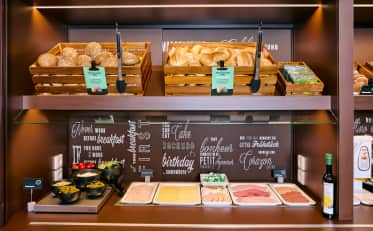Olympiastadion
Not far from Grunewald forest, Berlin's Olympic Stadium not only captivates soccer fans, but is also a popular venue for various events. Depeche Mode has already played here and Hertha BSC also plays its home games in this stadium. A visit or a guided tour with a professional guide to the former German stadium is also worthwhile for historical reasons. The huge earth stadium can look back on a long and exciting history. Join the 300,000 or so visitors who come to this unique stadium in Charlottenburg-Wilmersdorf every year and look forward to an unforgettable experience.
Origin and history of the stadium
Just in time for the 1936 Olympic Games, the well-known German architect family March was to build a new, more modern stadium on the site of the Deutsches Stadion in Charlottenburg. Under the specification that the new stadium should seat 100,000 spectators, March succeeded in constructing the building in a record time of just 28 months. The first conversion work was not carried out until between 2000 and 2004, when the Hamburg architects Gerkan, Marg and Partners modernized the stadium in preparation for the 2006 FIFA World Cup. Under strict monument protection regulations, the competition area was lowered further, a roof was installed over the spectator stands, floodlighting was installed and the historic natural stone on the walls of the stadium was cleaned. As the Olympic Stadium is still the home ground of Hertha BSC today, the tartan track was also dyed blue in the club's colors at the club's request. The result of all this renovation work was that the UEFA awarded the Olympic Stadium the status of a five-star stadium. After the official opening of the stadium on July 31 and August 1, 2004, various German and international soccer matches as well as numerous musical events, at which stars such as Nena, Pink and many others performed, took place in the Olympic Stadium. Last but not least, the DFB Cup has also been played here every year since 1985. The DFB women's final was also held here until 2009. In 2011, the Women's World Cup was even opened here. Finally, the Olympic Stadium was also the venue for the World Athletics Championships in 2009, where Usain Bolt set the world record in the 100 and 200 meter races. Hertha BSC has also played all of its home matches at the Olympic Stadium since 1963. Only during the UEFA Europa Conference League 2021/2022 were fans also able to experience the home games of FC Union Berlin in this stadium. A special event also took place at the Olympiastadion in September 2011. As part of his trip to Germany, none other than Pope Benedict XVI held Holy Mass here in front of thousands of visitors.
- Special features of the Berlin Olympic Stadium
- A look behind the scenes
- Transport links and parking spaces
Special features of the Berlin Olympic Stadium
Even today, the Olympic Stadium, which is over 300 meters long and almost 230 meters wide, is still part of the Olympic site, which also includes the Sportforum, the field hockey stadium, the Olympic equestrian stadium, the swimming stadium, the Maifeld, the Waldbühne, the Langemarckhalle, the stadium terraces and the old bell tower. Numerous sculptures and steles designed by various artists such as Joseph Wackerle and Karl Albiker can also be admired on these grounds. Meanwhile, the stadium itself was awarded the IOC/IPC/IAKS special prize for disabled-friendly sports facilities in 2007, which means that people with reduced mobility can also visit the stadium or play sport here without any problems. And while the catacombs beneath the stadium served as a production warehouse and security bunker during the Second World War, the enormous space of the building is now used for covered seating, boxes, honorary and press stands, the stadium chapel, the reporters' pit, changing rooms, underground garages and a comprehensive warm-up hall.
A look behind the scenes
Would you like to take a look behind the scenes of one of the most famous sports stadiums in the world and not just enjoy the view from the stands? Then you have the choice between a visit without a guide or a guided tour, which also gives you an insight into the various VIP areas or the athletes' warm-up hall. With a single ticket for around eight euros, all public areas of the stadium and the Olympic grounds are open to you. With the help of various information boards, you can then explore the history and special features of the stadium on your own. Instead, you can get insider knowledge during a guided tour. You can visit the players' dressing rooms as well as the underground areas of the building, the entire Olympic Park and, last but not least, the historic bell tower. Finally, a special themed tour can be worthwhile for dedicated soccer fans, during which you can visit the Hertha BSC club grounds, including the amateur stadium and training grounds.
Transport links and parking spaces
Regardless of whether you want to travel to the Berlin Olympic Stadium by train or private car, the connections are fantastic. There are several public parking lots on site, some of which are subject to charges, such as Olympischer Platz, parking lot P04 or P05 with disabled parking spaces, which you can use around the clock. Alternatively, you can easily reach the stadium by underground or S-Bahn. The Olympiastadion S-Bahn station is just 300 meters from the stadium and the U-Bahn station is also just 500 meters away.
Experience Berlin
Of course, there is much more to discover in the German capital than just the Olympic Stadium. In the Charlottenburg district alone, there are numerous highlights such as Charlottenburg Palace, the historic radio tower and the fascinating Brücke Museum. If you don't want to miss out on all these sights and much more, you should book a room in a suitable hotel in good time. So how about a stay at the comfortable Hotel Berlin Charlottenburg or one of the other B&B Hotels in Berlin? Visit our website and get to know our fabulous offer. Benefit from modern rooms with private bathrooms, free WIFI throughout the hotel, a comprehensive breakfast buffet and, last but not least, unbeatable value for money. We look forward to welcoming you!









































































